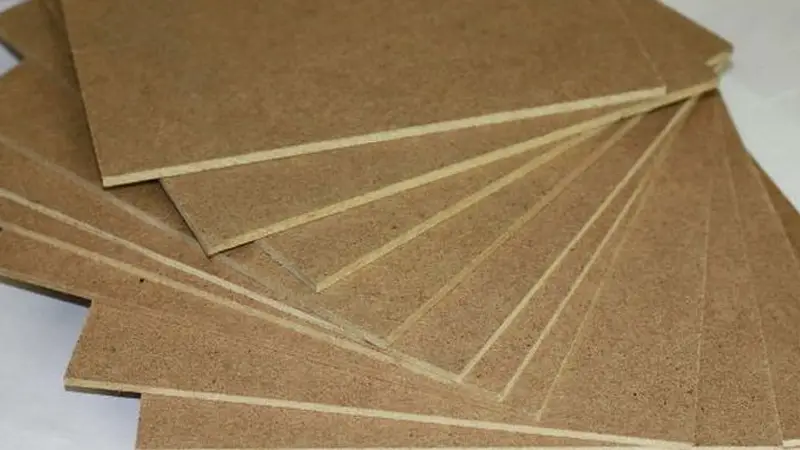IKEA is famous for being one of the best budget furniture brands in the United States. It’s common knowledge that cheap items always cut corners. With IKEA claiming durability and strength with the fiberboard material they use in creating some of their furniture, does it live up to the hype?
Fiberboard is an alternative to wood that’s commonly used in the furniture industry due to its durability and cost-effectiveness. While it’s not strong enough to be used for construction, it’s a more cost-effective alternative to regular wooden furniture, as long as you use it properly.
In this article, I’ll compare IKEA’s fiberboard to common alternatives like particleboard and wood. After going over some of the advantages and disadvantages of each, you’ll learn which of these materials is best for cheap furniture.
What Is IKEA Fiberboard?

Firstly, you shouldn’t have high expectations when buying pieces of furniture at IKEA prices. The cost for the entire furniture piece can barely cover the cost of the materials for a premium and well-made piece of furniture.
Fiberboard is a wood-like material formed by the breakdown of softwood in a defibrillator. In the process, it mixes with wax and a resin binder to form sheets of fiberboard sheets. Unlike the closely-related particleboard, fiberboard is made up of separated fibers that join together to form a single piece.
While fiberboard may not be as strong as real wood, there are some applications where it’s the better material. It’s also important to note that fiberboard isn’t unique to IKEA, as many different furniture companies use the material.
While I’ll outline the advantages of wood over fiberboard later in this article, it’s important to note that fiberboard is not stronger wood. If you’re looking for a structure that will last for as long as you can measure, you can never go wrong with good old hardwood.
If you’re looking to spend as little as possible to get the best possible furniture, fiberboard is a strong option. It doesn’t look or feel as sturdy or enticing as wood, but it’s also not as weak as particleboard. This article will go on to explain the differences between these materials and when to use them.
Is Fiberboard Real Wood?
Wood is objectively better than most other wood alternatives used in making household furniture. The strength and aesthetic excellence of work are currently making it the material of choice for furniture pieces that suffer a lot of pressure.
Before diving extensively into the differences between fiberboard and real wood, it’s important to have a basic understanding of what both of these materials mean.
Wood refers to the material that you harvest from trees. The real wood that’s used for furniture making is almost always hardwood for obvious reasons. Hardwood is much harder than any other wood-like material, making them the best material to create sturdy structures and furniture pieces.
But there’s a catch to using hardwood. Since it’s harvested directly from plants that take decades to grow, it’s naturally very expensive. For someone trying to set up an inexpensive home, wood-based furniture is too expensive.
To solve this problem, researchers attempted to create cheaper alternatives to wood, and they’re partly successful. Cutting costs will always directly lead to a cut in quality. Since fiberboards are a cheaper alternative to wood, you should expect a drop in quality.
Fortunately, the price drop is greater than the quality drop, making fiberboards a cost-effective alternative to wood. Unless you’re willing to use the same set of furniture for decades without a change, your fiberboards should hold up well.
When it comes to industrial applications like construction, fiberboard starts to show its weaknesses. Wood is used exclusively in construction because no cheaper alternatives just as durable as wood.
In the next section, I’ll go over some of the advantages and disadvantages of fiberboard, compare it to real wood, and see how the two materials stack up in a real-life application.
Is Fiberboard Better than Wood?

At this point, it’s already certain that fiberboard and wood are two very different materials. With the technical explanations, however, it’s still difficult to determine which of the two materials is stronger.
While fiberboard is much stronger than most non-wood alternatives to wood, it’s not quite on the same level as wood. This is to be expected, as the material is a lot cheaper than the conventional wood that is used in construction and furniture making.
To determine which of these materials is stronger on an objective front, it’s important to look at some of their pros and cons.
Advantages of Fiberboard Furniture
There are many reasons why you may want to buy a piece of fiberboard furniture, but not any reason why you’ll choose it over wood. Apart from the lower prices, you’ll be hard-pressed to find an advantage of fiberboard that it doesn’t share with hardwood.
One of the unique pros of fiberboard is the fact that it doesn’t shrink or crack, while wood does. Wood furniture pieces tend to shrink in cold weather, only to expand when it gets warm. If there is no balance between the two, you may start to notice cracks in your furniture piece due to excessive shrinking.
You wouldn’t have to worry about that problem if you stuck to fiberboard furniture. This advantage makes it possible for fiberboard-based furniture to retain their original size and shape, as long as they don’t carry a 90kg weight.
Advantages of Wooden Furniture
Wood is simply incomparable to fiberboard. It’s technically superior to fiberboard in durability, aesthetics, customizability, etc. If you can afford wooden furniture, there’s no real reason why you should go for any other alternative.
Wooden furniture doesn’t need to be put on a coat of paint. The natural color of hardwood is one of the dominant colors in nature. Consequently, wood-based furniture can fit in almost any setting without any modification or painting.
If you don’t mind the temperature sensitivity that gives rise to shrinking and cracking, there are no better alternatives to hardwood. If you want to keep to a specified budget, however, buying wooden furniture exclusively may not be very cost-effective.

